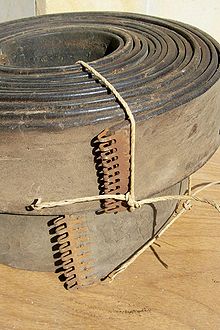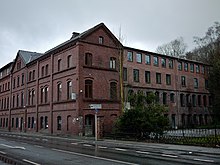Leather and tanning museum
The Leather and Tanning Museum in Mülheim an der Ruhr is dedicated to the history of development and the manufacturing process of leather and its diverse end products. The museum was opened in September 2003 and is part of the Route of Industrial Culture (Theme Route 12 - Past and Present of the Ruhr ).
History of the museum
The city on the river has a centuries-old relationship with the tanning trade . Leather has been produced on the Ruhr and the flowing streams for more than 350 years, and the extensive oak forests also played an important role as a supplier of tannins. Artisanal tannery and the later industrial leather production were an important economic factor of the city up to the beginning of the 20th century, alongside the coal and steel industry .
Shrinking processes within the textile industry led to the decline of the economic branch and to the fact that of 50 tanning and leather manufacturers in 1924 only one manufacturing company remained - the Lindgens leather factory listed in the Route of Industrial Culture .
The museum, which was built in the former Abel leather factory from May 2002 to September 2003 , is intended to document and preserve the economically important aspect of Mülheim. It was fully financed by the NRW Foundation .
The museum collection

The museum is privately run by a development association. Historical equipment and modern tools and production processes in tannery and leather production are shown. Some of the semi-finished and finished products on display can be touched and the visitor learns what an ass leather is and what the skin of a whale feels like. Interactive and multimedia stations complete the museum offer.
literature
- Melanie Rimpel: Abel leather factory . In: Leather - Industry - Architecture, pp. 40–47. Mülheim an der Ruhr, 2004.
Web links
- Homepage of the leather and tanning museum
- metropolitan clock over the museum
- "From the cow to the shoe" - NRZ report ( Memento from February 18, 2006 in the Internet Archive )
- Building description in the list of monuments of the city of Mülheim
- NRW Foundation (funding)
- Description of all locations on this themed route as part of the Route of Industrial Culture
Coordinates: 51 ° 24 '57.3 " N , 6 ° 52' 4.8" E

